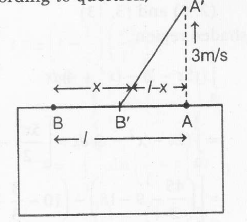Answer:
Option *
Explanation:
According to question,

Given,
AB is an iron rod whose length is given by
l=1.5 m
velocity of end A,
v=3 m/s
Let t be the time when both the ends have same speed. since end A has always a constant velocity, therefore the velocity of end B at point B' is also become 3 m/s.
In the position of B'A' of the rod, i.e, after time t,
$(l-x)^{2}+(3t)^{2}=l^{2}$
$(1.5-x)^{2}+9t^{2}=(1.5)^{2}$
$2.25+x^{2}-3x+9t^{2}=2.25$
$x^{2}-3x+9t^{2}=0$ ............(i)
As rod is moving with a constant velocity then from equation of the motion,
$x=ut+\frac{1}{2}at^{2}$
x=3t .............(ii)
[ $\because$ velocity ,u=3 m/s and accleration , a=0]
From Eqs.(i) and (ii)
$(3t)^{2}-3(3t)+9t^{2}=0$
$9t^{2}-9t+9t^{2}=0$
$18t^{2}-9t=0 \Rightarrow t= \frac{1}{2}$